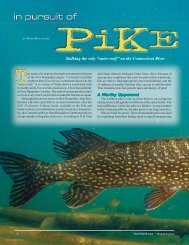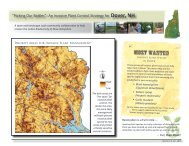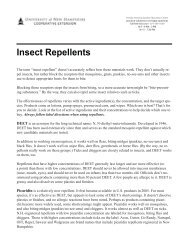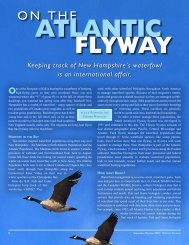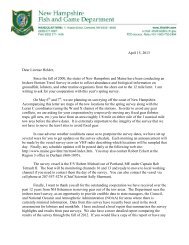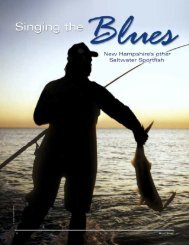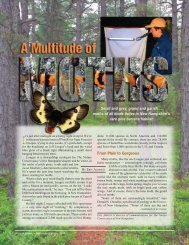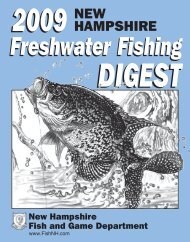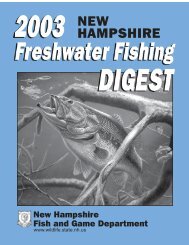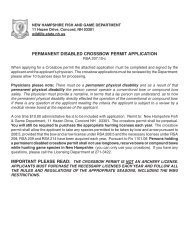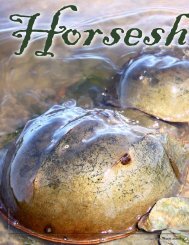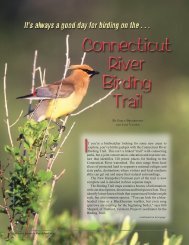Shellfish<strong>New</strong> <strong>Hampshire</strong> has oysters, clams <strong>and</strong> mussels accessible for recreationalharvest. License may be required.• Mollusks (clams, oysters, mussels, etc.) may only be takenfrom approved areas. (See map on pages 24–25).• Motor vehicles are prohibited on clam flats (any tidal area,exposed at low tide, that is capable of growing clams).2012 Recreational Shellfish Regulations*SPECIESBlue Mussels(Mytilus edulis)OystersSea ScallopsSoftshell Clam(Mya arenaria)Quahog, little neckor cherrystone clam(Mercenaria mercenaria)Other Bivalve Mollusks(surf & razor clams,mahogany quahog)WhelksSeason/Day/TimeRestrictionsNo closed seasonexcept for Hampton/Seabrook Estuary• Open Sept. – June• Sunrise to sunsetonlyOpen November 1 –April 14• Day after Labor Day– May 31 except forHampton/SeabrookEstuary• Saturday only• ½ hr. beforesunrise to sunsetNo open seasonSizeLimitLicenseNeededNo limit No limit NoNo limitMin. 3½inchesshellheightNo limit½ bushelunshucked/day200 lbs shuckedmeats or 1,666 lbsunshucked (shell)/day10 liquid quartsunshucked/dayYesNoYesNo closed season No limit No limit No• No closed season• Harvest only from1 hr. before sunriseto sunsetMin. 2½inches2012 Commercial Shellfish Regulations*SPECIESSea ScallopsOther Bivalve Mollusks(surf <strong>and</strong> razor clams,mahogany quahog)WhelksSeason/Day/TimeRestrictionsOpen November 1 –April 14No closed season• No closed season• Harvest only from1 hr. before sunriseto sunsetSizeMin. 3½inchesshellheightNo limitMin. 2½inches5/dayLimit200 lbs shuckedmeats or 1,666 lbsunshucked(shell)/day500 unshuckedbushels/dayNo limitNoLicenseNeededYesYesNotes• Residents only• Personal use only, no sale allowed• Harvest by h<strong>and</strong> or h<strong>and</strong>held tools only• Other mussel species (e.g. horse <strong>and</strong> ribbed mussel) mayalso be taken• Hampton/Seabrook Estuary only: ½ hour before sunrise tosunset on Saturdays only, open Nov. 1 – May 31• Residents only• Personal use only, no sale allowed• May be taken by h<strong>and</strong> or tongs only• No taking through ice• No shucked oysters may be possessed while on or leavingN.H. waters• Oyster license number must be permanently marked onoutside of container• Must have oyster license on person• Personal use only• May be taken by diving• Must be l<strong>and</strong>ed in shell if taken by h<strong>and</strong>• Residents only (6 years of age or older)• Personal use only, no sale allowed• License must be displayed in plain view while clamming• Clam license number must be permanently marked onoutside of container• H<strong>and</strong>held tools only, with h<strong>and</strong>les not exceeding 18 inches.• No shucked clams allowed on or while leaving N.H. waters• Hampton/Seabrook Estuary only: ½ hour before sunrise tosunset on Saturdays only, open Nov. 1 – May 31• Residents only• Harvest by h<strong>and</strong> or h<strong>and</strong>held tools only• Harvest of surf clams <strong>and</strong> quahogs limited to approvedwater within 500 feet of low tide line• Personal use only• Residents only*Important Note: Temporary closures of shellfishing areas may occur due to high bacteria count or red tide or other pollution concerns.For updates, call the Clam Flat Hotline at 1-800-43-CLAMS.• Call 1-800-43-CLAMS for current open/closed status of NHshellfish areas. Temporary closures during open seasons mayoccur due to high bacteria levels, red tide or other issues.• Sale prohibited. Softshell clams <strong>and</strong> oysters of N.H. origin, <strong>and</strong>quahogs, littlenecks <strong>and</strong> cherrystones (Mercenaria mercenaria)less than 1 inch in shell thickness cannot be sold.YesNotes• May be taken by diving or one dredge only• Must be l<strong>and</strong>ed in shell if taken by h<strong>and</strong>• Dredge: width limit = maximum 4 feet., ring size = 4 inches,minimum mesh size = 10 inches• No obstructions, chafing gear or liners attached in dredge• No possession of other marine species when dredgingexcept surf clams <strong>and</strong> mahogany quahogs <strong>and</strong> only inaccordance with species regulations• Dredge blade/knife/manifold: maximum 48 inches.• Monthly reporting required: Contact Marine Division(603) 868-1095• Harvest by pot, trap or other contrivance• Each buoy <strong>and</strong> trap shall be marked with a “W” <strong>and</strong> the firstinitial <strong>and</strong> last name of licensee when fishing solely for whelks22 2012 <strong>New</strong> <strong>Hampshire</strong> Saltwater <strong>Fish</strong>ing Digest
Shellfish Identification<strong>New</strong> <strong>Hampshire</strong> is fortunate to have a rich variety of molluscan shellfish.Some of the most frequently seen are easy to identify by their shellshape <strong>and</strong> color.Shellfish illustrations: ©Hans Hillewaert CC 2.5: Mahogany Quahog, Razor clam;©Invertzoo GNU Free Documentation License: Surf Clam; ©<strong>Fish</strong>eries <strong>and</strong> Oceans Canada:Waved Whelk; ©NHFG/Victor Young: Ribbed Mussel; ©Pallbo: Blue MusselBlue MusselRibbed MusselSea ScallopOysterSurf ClamSoftshell ClamRazor ClamMahogany QuahogHorse MusselWaved WhelkStimpsons WhelkQuahog(Mercenaria mercenaria)NOTE: SHELLFISH CLOSURES MAY CHANGEMost of <strong>New</strong> <strong>Hampshire</strong>’s coastal waters (up to 3 miles offshore)are open to shellfish harvest, with the exception of surf clams <strong>and</strong>quahogs, which can be harvested for consumption within 500 feetseaward of the low tide line. In addition, several small areas alongthe coast are closed due to pollution concerns. These areas includethe outlets of Parsons Creek <strong>and</strong> Eel Pond in Rye, an unnamedcreek near Bass Beach in Rye, <strong>and</strong> Chapel Brook. All waters within750 feet of each outlet are closed to shellfish harvest. Additionally,all waters within 1,500 feet of Little River (near North HamptonState Beach) are closed to shellfish harvest. Also closed are areasaround the wastewater treatment plant outfalls at Wallis S<strong>and</strong>sState Park, the Town of Seabrook, <strong>and</strong> Star Isl<strong>and</strong> (Isles of Shoals).Other areas may close temporarily at any time. For up-todateinformation, call <strong>Fish</strong> <strong>and</strong> <strong>Game</strong>’s Clam Flat Hotline at1-800-43-CLAMS, check www.<strong>Fish</strong>NH.com (Marine Resources),<strong>and</strong> consult the information <strong>and</strong> maps on DES’s Shellfish Programwebsite: www.des.nh.gov (search “shellfish”).from April to October. If PSP toxins exceed state st<strong>and</strong>ards forconsumption, shellfish harvesting areas are closed <strong>and</strong> publicnotice given via news media <strong>and</strong> the <strong>Fish</strong> <strong>and</strong> <strong>Game</strong> website. Contact<strong>Fish</strong> <strong>and</strong> <strong>Game</strong> Marine <strong>Fish</strong>eries Division at (603) 868-1095or the Department of Environmental Services at (603) 559-1509,weekdays from 8 a.m. to 4 p.m., for updated information. Evenwhen red tide closures are not in effect, some areas may be closedto the taking of shellfish (see Shellfish Closures May Change).RED TIDERed tide is caused by the accumulation of toxins from one-celledorganisms. The toxins may be stored in the bodies of filter-feedingbivalves, such as clams, mussels <strong>and</strong> oysters, which ingest theorganisms. Humans who eat the shellfish may become afflictedwith paralytic shellfish poisoning (PSP), which can cause deaththrough respiratory paralysis. Mussel samples are tested weeklywww.<strong>Fish</strong>NH.com 23



